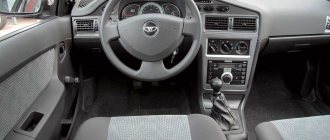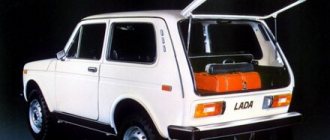The day when a pedestrian transfers to his own car will probably always be remembered by every current owner of an iron horse. The first car that becomes a good simulator for proper driving and a real guide on how to repair a car with your own hands can be the VAZ-2114. It is not a pity to use this vehicle for a variety of purposes, while the mechanics allow you to save money on repairs yourself.
Is it the case that the Chevrolet Lanos - at first glance, it seems to be a much more modern car, but is it really so? We addressed this question to specialists and vehicle owners who managed to try both of these cars on the road.
Mitsubishi Lancer IX
The car, which was used by heroes of cult racing films just a decade ago, is available for only $6,500-$10,000. Its peculiarity is its aggressive character. This car is not as practical as previous models due to the smaller trunk volume. In Lancer it is 430 hp. But compared to the Sens, this luggage compartment is simply huge, since in a domestic sedan car its volume is only 322 liters.
The car, intended for active driving, is equipped with three types of gasoline internal combustion engines with a volume of 1.3, 1.6 and 2.0 liters. The Japanese was not produced with a diesel engine. Its version with an automatic transmission is particularly convenient and reliable. Depending on the configuration, the sedan consumes 6.5-8.4 liters of fuel per 100 km.
The Lancer has an image of a driving car. With a two-liter unit, it effortlessly overcomes the 200 km/h mark, and reaches the first hundred in 9.6 seconds, while the Sens needs almost twice as much time to reach such a speed, namely 17 seconds. It’s definitely not possible to show your character on the road in a ZAZ, but the Lancer IX was created just for this.
The Japanese equipped the car with electronics. ABS, climate control, airbags, heated seats, mirrors and other technologies ensure comfort and safety on any trip. But its maintenance will cost more than the models discussed above, although it remains within a reasonable price range. The average cost of maintenance for a car with a two-liter engine and automatic transmission is about 4 thousand UAH. for 15,000 km. Servicing the version with a 1.6-liter internal combustion engine and manual transmission will cost 2.5 thousand UAH per 15,000 km. mileage
Sometimes many VAZ owners have the question “shouldn’t I buy a foreign car?”
Buy a domestic car or a foreign car - each of these steps has its fans and each of them has its own reasons and arguments. Expensive spare parts, reliability, better equipment, cheaper, more spacious interior,... In the end, everyone decides what to buy, but you must agree that in order to make the right decision, you need not only to see all the potential options live, but also to get as much information as possible on each of the contenders. We are publishing a comparative test drive of the Za Rulem magazine of VAZ 2115 cars and 2 modifications of Daewoo Lanos
TIME AGO
I remember that day very well, even though more than ten years have passed. It was the first time I had to board a trolleybus with such a hefty wad of currency. The feeling of tension disappeared only when I crossed the threshold of the car dealership. And then there was childish joy! The snow-white “nine” that I dreamed about so much is finally mine!
Memories came flooding back as soon as I opened the door of the 115 and inhaled the same plastic smell of a new car. I got behind the wheel, and again: I remember a terrible traffic jam on the way from the airport, in which I spent five hours and was ready to abandon the car, if only this “knife” - the pipe of the seat frame - would be taken out of my back. On the Lada-115 it is still in its place...
True, the new instrument panel is more informative, the front panel does not creak like in the old days, the steering wheel is height adjustable, and under the hood there is a more powerful engine with distributed injection. Turn the key, and the whole body shudders and the car comes to life. Vibrations are the model’s calling card. They are always and everywhere: on the steering wheel, pedals, levers, seats. But on the move they hardly bother me anymore. Now everything is drowned out by a noisy engine and a transmission that itches in different ways, depending on the speed. How so? I remember for sure that my “nine” didn’t have this even with a mileage of about a hundred thousand! For some reason I want to protect the car: “Maybe I should change the oil in the box?” – this is the syndrome of the owner of domestic equipment.
There is no doubt that you will have to put your hands on the car. And we’re not talking about the obligatory “anti-corrosive alarm” survival package. First, many will want to change the steering wheel. The regular one is not only terrible to look at and feel, it also bends in your hands! If designers solve the problem of injury safety in this way, all that remains is to shrug their shoulders. I would also like to sort out the seats - in addition to that very “knife” in the back, the joint between the pillow and the back is loose.
Don't go on a long journey until you've checked your brakes. Our copy, despite pre-sale preparation, is not ready for real life. Intensive braking revealed: first, the pads of the front left wheel “grabbed”, and as the pedal was pressed, the left rear wheel began to work. Only after a dozen cycles the car began to stop more or less confidently, but in terms of braking distance it still found itself an outsider.
Next, you will have to install a stretcher between the front pillars in order to at least slightly increase the rigidity of the body. When I took the passenger’s seat during the next race along the mountain road of the training ground, in a sharp turn I felt the right door knocking in the opening. At first it even seemed that it was not closed completely. No, the point is precisely in the “plasticine” body. Naturally, you can't expect good handling. The car suffers from rolls and when cornering it tries to tear the rear inner wheel off the asphalt. Where are you, the famous “eight” handling?
To rehabilitate the “one hundred and fifteenth” a little, I’ll praise the good engine, which readily pulls from low revs, as well as decent smoothness – you won’t be afraid of this suspension on our roads. In addition, the “tag” has the most spacious trunk. And another huge plus is that you will find spare parts and service at any time in any city in Russia.
BLOOD BROTHERS
If you want to live, know how to spin. This truth is well illustrated by the Ukrainian ZAZ, which managed to restructure itself in accordance with the requirements of the time. What they don’t collect at this enterprise now! Cars for every taste and budget - Mercedes-Benz, Opel, Chery, Chevrolet, Sens. The appearance of the latest brand or model was dictated by the desire to make a budget car, and at the same time give work to the Melitopol engine, but with a local power unit and an original rear design. The engine and transmission are well known to those who have driven Tavrias in recent years. The sedan is sold in a single configuration, if you can call it that, the absence of almost everything that makes the car more or less comfortable. No power steering, no electric windows and mirrors, no, God forbid, air conditioning. By the way, as you understand, there are no airbags either...
Nevertheless, after the Lada, the Sens gives the impression of a much more modern car. Quite harmonious appearance, neat door trim and simple but high-quality seat fabric. The seating position is high, so much so that large drivers feel the proximity of the ceiling. The controls are logical, with the exception of the gearbox. The owners of Tavria will cope without problems, but the rest will be forced to retrain. To engage fifth, you need to move the lever to the right and back. Accordingly, to shift from fourth gear, you need to “draw” the letter P with the lever, which none of the experts was able to do without making mistakes - neither on the first nor on the second attempt.
I unexpectedly liked the motor. And although dynamics measurements say that from 60 km/h the Sens rapidly “withers”, this does not spoil the driving sensation much. Of course, with a full load, the Sens will have difficulty going uphill. But for its 1300 “cubes” the engine has enough torque, and the gear ratios are chosen well, so you won’t have to use a fuzzy and confusing gearbox again.
What if you still go faster? There are no problems with feedback on the steering wheel. In extreme modes, the sedan goes outward “under the throttle” and dives into the turn when the gas is released. Everything is clear and logical, but in an effort to lighten the steering wheel, the designers had to increase the number of revolutions from lock to lock, so the steering wheel often has to be intercepted.
“Now close your eyes and in a minute give a short report on the car,” suggests a colleague. The overall impression of the Sens is that it is unhurried, solid, with a comfortable suspension, convenient for city driving.
WHAT DOES THE CROSS DO
To be honest, when I transferred to Lanos with a golden cross on my nose, I thought that I would experience approximately the same emotions. Yes, there is a more solid steering wheel, the door trims are thicker, and the driver and passenger seats are located slightly lower - high ones are much more comfortable. Everything changed as soon as the engine was started. After the Russian car with its “singing” transmission and noisy tires and the Sensa with a loud engine, the Chevrolet Lanos captivates with its silence and lack of vibrations.
The next pleasant sensation comes from the transmission. Despite the rather long lever strokes, compared to the previous two, the box seems to be a standard one. You engage the gears with two fingers; there is no question of “looking” for them. On the move, it seems that the Lanos is 200 kilograms lighter than the Sens, it takes off with such joy. Objectively inferior in dynamics to the Russian car, the Chevrolet drives with pleasure, and not under pressure. The car takes corners just as optimistically. The power steering steering is not only comfortable in the city, but also does not force you to “wind up” on it in sharp turns - there are three turns all the way.
In addition to electric windows and central locking, the test car has air conditioning, which is a completely different quality of life... for which, of course, you have to pay! The most expensive Lanos is separated from the Sens and the Tolyatti car by a quarter of the price. But the liquidity of a “sophisticated” car on the secondary market will be higher, and your mood on every trip will be better. Considering that many people now change their car after three years, every day of owning a Lanos will cost 50 extra rubles. Or is your good mood not worth it?
"LADA-115"
- the new engine did not make it much more attractive. Outdated design, poor build quality and materials nullify the good intentions of the creators.
Overall rating 6.9
+ High ground clearance and reliable protection of the engine compartment, good ride quality, spacious trunk. — High noise level, tendency to rock, unstable brake operation, loud heater fan, cramped rear seat.
SENS
– even with a weak engine and an unsuccessful transmission, it is ready to compete with domestic models. Many can be stopped by poor service and problems with some spare parts.
Overall rating 7.4
+ Highly smooth running, good assembly, attractive price. — Unclear, difficult gear shifting, lack of power on the highway, a large number of steering wheel turns to the stop, lack of protection for the engine compartment.
CHEVROLET LANOS
– in the most expensive configuration, an easy-to-drive, practical car; acceptable level of comfort for reasonable money.
Overall rating 7.7
+ Air conditioning, electric drives and airbags are among the options, clear handling, convenient acceleration control, relatively low noise level. — Mediocre smoothness, some difficulties with spare parts, high price of the “top” version.
On my own behalf, I would only like to add that in Ukraine there are no problems when operating both Sens and Lanos. Spare parts are more expensive than VAZ ones, but finding them and fixing the car is not a problem. Perhaps in Russia the situation with this is somewhat different
Driving force: Chevrolet Lanos engines and gearboxes
It’s easiest with our sedan under the Chevy brand: it has a 1.5-liter naturally aspirated engine with no options and a manual transmission too.
An engine with a cast-iron cylinder block and a timing belt drive runs and runs for up to 200+ thousand km, after which it may require a major overhaul. Nuances during operation - do not overheat, regularly change valve stem seals, do not skimp on fuel and lubricants. With such introductory information, it travels up to half a million kilometers and further.
Attachment parts may require attention: starter (3000-7000 rubles per part) and thermostat (500-600 rubles) here as consumables.
The box can be considered one of the disadvantages of the Chevrolet Lanos. Weak points include low clutch life (100 thousand km maximum), drive play, wear of synchronizers, oil leaks from under the oil seal... In general, before purchasing, the Lanos transmission should be inspected as meticulously as possible.
As for the later variations of Sense/Chance, it is better to avoid the “original” 1.3 liter engines: their roots go back to the Soviet Union and Tavria, there are a minimum of spare parts, and they are not famous for their service life.
They also make noise, get hot and have no luck.
Also read
: He’s not your “Kalos”: Chevrolet Aveo I (T200) review
Owner reviews of the VAZ-2114
Controversy constantly arises regarding the Chevrolet Lanos and the VAZ-2114, some defend the right to be called the best car among budget vehicles for the VAZ-2114, others provide new evidence of the good quality of the Chevrolet Lanos.
Here's what you can read on the forums about the VAZ-2114:
- Perhaps the only positive thing that can be written down is that the VAZ-2114 is an inexpensive and economical car, but it has to be repaired very often.
- The only thing I'm not happy with is the volume of the car, I'm a taxi driver, and sometimes I still have tinnitus after a work shift. I’m thinking about upgrading my swallow, I’m not going to part with it just yet. I can repair it myself if I have to, but otherwise it’s an excellent workhorse.
- Parts and other consumables are of course cheap, but there are defects in literally all components - the brake pads don’t work, the engine is acting up, or it’s time to change the belt. I would call the VAZ-2114 a means of transportation, it doesn’t look like a car.
- Service it in a timely manner and the VAZ-2114 will not let you down!
- The creaking of the sidewalls and shelf finishes off, the functionality of the idle speed control suffers, and the electric pedal is unfinished.
- As for me, the whole car is a complete minus.
This is new.
The most interesting thing, of course, is hidden under the hood. The VAZ-21070-20 has a VAZ-2104 engine with many components familiar from front-wheel drive cars. There is a recognizable mass air flow sensor and a square air filter from the VAZ-21214 instead of the usual round one. A module with a throttle valve and its position sensor forced us to switch to a cable throttle drive. It was difficult to find a place for the fuel vapor adsorber - it got stuck under the main brake cylinder.
There is a modern wiring harness and a fuel filter conveniently located under the hood (not under the bottom). True, there is no knock sensor - due to the lack of a tide under it on the cylinder block.
The Slavuta has much more space under the hood, although there is a spare wheel located here. There are also modern wiring harnesses here, just like on the “Seven”, there is a hydraulic headlight leveler. They say that all the engine seals and gaskets were replaced with better ones, hoses were made from different rubber, and the supports became more powerful. A lot of good things have appeared, but now scheduled maintenance will have to be carried out in the pit. The oil filter can be removed from the engine only from the bottom, and the fuel filter is located under the bottom.
Exhaust gas neutralizers are located under the bottom. You become convinced that these are implants that were not provided for in advance when you crawl under the cars with a ruler.
For an unloaded Slavuta, we measured 145 mm of ground clearance under the exhaust system, which is already not enough, and under the S7’s neutralizer - only 135. Do you think we were unlucky with this particular specimen?
No - the instructions for the Zhiguli indicate that with the maximum permitted weight, the clearance under this expensive thing is... 90 mm! We also read interesting things in the instructions for the ZAZ-11308. For example, that all cars with a 1.3-liter engine (both with injection and with a carburetor) must be filled with AI-95 gasoline. In general, we wanted modern cars, and we got them.
VAZ 2114,2115 or Lanos, Nexia or used foreign car?
What's better to buy?
Probably similar questions have been asked a million times already, but still.
There are not very good reviews about Lanos and Nexia.
Vaz is vaz, what can you say.
A used foreign car (Toyota King, for example, year 96) is a lottery.
For 200 thousand NEW - only VAZ classic or OKA (with all additional extras, insurance, and cast winter tires).
And Samara-2 (13, 14, 15) and Nexia are more expensive.
It's more a question of price and quality. And the quality on VAZs is simply unique, only people come to us to change consumables, and at the same time their cars drive 200 km a day, and some only eat along the home-work-home route and sit in the service station on weekends.
It seems to me personally that the VAZ is not such a bad car, and its reliability apparently depends on the shift that assembled it.
Good day everyone. Guys, I have the same problem - I want to buy a used VAZ 14, 1.6 engine, 16 valve, 08.07. , or Daewoo Lanos 0.5, 0.6 year of manufacture, I can’t decide what to buy. The fact is that Kavo has 9s, they recommend 14s, Kavo Lanos or Sens recommend them. I want to take the car for myself (so that I'm 28 years old, I like to trot and ride in comfort (if I'm traveling with my wife and child). Please advise, there are no words. Thank you very much in advance.
Similarities
Both cars presented have been on the market for more than 20 years . Today, the peak of their popularity has passed. We can say that they are outdated both from a moral and technical point of view.
The main point that attracts buyers is the relatively low cost . These are ordinary budget cars with a modest (by today's standards) set of options, a rather “gray” appearance and average engine and chassis performance. The main type of transmission in both cases is mechanical.
Anti-corrosion protection
In order for the body to be durable, anti-corrosion protection is used for ZAZ Sens. Body parts are made by cold stamping, then a protective coating is applied to them, zinc-nickel MG 30/30 and zinc GA4S/45. To cover parts that are in direct contact with an external aggressive environment, a zinc-nickel protective layer is used, and for parts that have indirect contact, zinc protection is used. The bottom of the car and the sills are protected with zinc on the outside. The trunk lid, outer doors and hood are treated with a layer of MG, and hidden parts of the body, side members and inner lining of the engine compartment are coated with GA4S. 83 body parts are subjected to zinc-nickel processing, the rest are covered with a paint and varnish layer.
. not quite forgotten old
A quick glance at the car interiors will certainly give you the idea that the interior of the Slavuta (and this is the “luxury” package) is closer to today. It is stylistically more elegant, the buttons are nicer, and in the dark almost everything is illuminated, unlike the Lada. However, once you start using the machine, you will certainly notice that the Tavria deflectors are capable of deflecting heat or coolness only in one plane, and it is impossible to direct the flow up or down at all - there is no such engine on the panel. There are, however, two handles at the feet of the right passenger. They can be set to the desired position before driving. They work on a “yes-no” principle: one allows or does not allow air to the heater radiator, the other directs heat or blocks its access to the driver’s feet. In general, the age of design developments cannot be hidden with updated panels.
The 7, with its tired interior and venerable age, has better climate control. But, as in “Slavuta”, the weak fan of the “stove” allows us to talk more about warmth or coolness, rather than about flows from the deflectors. Therefore, to prevent the rear windows from freezing in winter, drivers of both cars should open one of them slightly.
The interior of the Zhiguli is somewhat more spacious than that of the Tavria; it better suits the family purpose of the car. However, the driver here has a harder time, both literally and figuratively. The steering wheel and pedals are tighter, and rear-wheel drive often requires more careful throttle operation. However, we'll talk about controllability later.
A person driving a Lada car has to... group too much. They jokingly say about this position: knees behind the ears.
In Slavuta, the driving position is more correct. The bend angles of the legs, arms and torso correspond to current ideas about ergonomics, but the steering wheel rim is unusually thin.
The rear seats of the Tavria are cramped for adults. But what a trunk! And its volume in its normal state is exactly the same as that of the “nine”, and the loading height is small, and the rear seats are transformed, forming a flat floor.
Experts' opinion
According to experts, the VAZ-2214 has the following negative characteristics:
- It’s hard to imagine this car model without vibrations; we can say that this is its calling card; vibrations decrease when driving;
- the engine has increased noise levels;
- The condition of the steering wheel leaves much to be desired - if a strong driver is behind the wheel, it is easy to bend it;
- any passenger, taking his place in the back seat for the first time, will feel the delights of the articulation of the pillow and the backrest - as if a knife is stabbing into the back;
- The braking mechanism is also imperfectly adjusted. First, the pads of the left front wheel come into effect, and then the braking goes to the left rear (to solve this problem, service station specialists recommend installing a stretcher between the front pillars in the VAZ-2114, this method will increase the rigidity of the body);
- Often, even a practically new VAZ-2114 model knocks in the right door in the opening; it’s all about the “plasticine” body, which is why the ability to control the raspberry with high quality and precision suffers.
Now about the good things about the VAZ-2114:
- good engine that works well from low speeds;
- good smoothness of movement - on Russian highways the suspension is just right;
- spacious trunk - even construction materials can fit here;
- It is not difficult to find spare parts and select parts, which speeds up repair work in case of problems in the VAZ-2114.
As for the Chevrolet Lanos, the car is budget, but made to resemble a foreign car - the rear part is represented by a Korean-Polish design.
The inconvenient thing is that when buying a car you don’t have to wait for a spare part – there is no power steering or electric windows. All this has to be purchased additionally; in general, a car that claims to be of a higher class requires a little modernization and alteration, starting with the same airbags.
What pleases us about the Chevrolet Lanos is its harmonious external design, high-quality door upholstery and, albeit modest, but at the same time reliable fabric used for the seats. The car's controls are convenient, but the gearbox leaves much to be desired. The engine, like in the VAZ-2114, is good. The ceiling has lost ground, and all because of the high seating position of the driver's seat, so it will be uncomfortable for tall drivers to drive the car. The general impression that the Chevrolet Lanos evokes among experts is that it is unhurried, well made, the suspension is of good quality, suitable for driving around the city, the steering wheel is solid, the upholstery on the doors is thicker than that of the VAZ-2114.
If you are thinking which engine is better, the VAZ-2114 is distinguished by its liveliness, the car needs less fuel, but the Chevrolet Lanos has a longer resource - free passage without problems up to 300,000 km, while a major overhaul of the engine in the VAZ-2114 is required after 180,000 km mileage
What else distinguishes the Chevrolet Lanos from the VAZ-2114 is the silent operation of the engine - what a bliss it is not to hear extraneous sounds after the loudly singing engine of the VAZ-2114. The Chevrolet Lanos also does not produce any vibrations, the transmission remains pleasant, there is no need to look for gears - just a slight movement of your fingers is enough to turn it on.
Driving a Lanos after a VAZ-2114 is easier, simpler, more comfortable, the car seems to rush into the distance itself, there is no need to kick it. Turns are smooth even on tight turns. In general, if you want a better ride, give preference to the Chevrolet Lanos - this is the verdict of leading experts.
Chevrolet Lanos, ZAZ Chance
Externally, the Lanos and Chance sedans are twins, the only difference being the shape of the lights and the inscriptions on the trunk lid. There are more differences inside. Getting behind the wheel of a Chevrolet while maintaining a proud posture is not easy: the seat is too low. However, it is comfortable to sit in. But the interior is uncomfortable - everything seems to be in place, but there is clearly a lack of at least some decor. The only thing pleasing to the eye is the silver trim on the top of the panel.
It’s easier to get comfortable in the Zaporozhye “Chance”: the chair here is installed higher. This advantage turned into a disadvantage. The large steering wheel, not the best shape, covers the entire upper part of the dashboard - the instruments are not visible. There are no seat height adjustments. The rear sofa is comfortable both in terms of rigidity and backrest angle. The trunk is quite roomy, the same in configuration and volume as that of a Chevrolet.
Owner reviews of Chevrolet Lanos
Whether the Chevrolet Lanos is better than the UAZ or not, judge for yourself based on the reviews of the owners of the first brand of car:
- Maintenance is too expensive and does not match the appearance and comfort of the car in the cabin when driving. A foreign car is the only plus.
- The noise insulation is ideal, the stove is not satisfactory, it needs a long warm-up. Sometimes the thermostat doesn't work.
- You know exactly how the car will behave on turns and on the track. Dips and dents easily remain on the paintwork.
- When the car's air conditioning is on, it drives slower. I would add power steering.
- A fast and reliable engine, a convenient and comfortable foreign car.
The car quickly rusts and even rots, I was shocked after the winter passed - store it only in the garage! But if you choose which is better - a Chevrolet Lanos or a VAZ-2114 - the first one definitely wins! I've been driving it for 6 years, but the air conditioning is not enough, it needs to be built in additionally.
Choice
The simplicity and modest technical characteristics of the models under consideration exclude the possibility of their use as sports, executive or off-road vehicles. They can be used for daily trips around the city in cases where there is no need to emphasize status or make an impression.
Operation, maintenance and repair of a Russian car are cheaper, but long trips can cause a lot of inconvenience to the driver and passengers, so it is better to choose a Chevrolet for traveling long distances.











